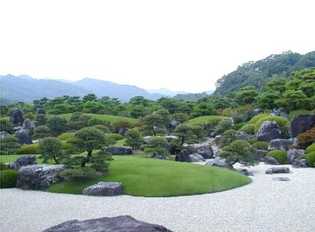庭園と石 - Gardens and Rocks
The first religions of this wonderful country worshipped rocks mountains, rivers, and forests. This religion was that of Animism – probably the most ancient religion in the world. This brings us to the beautiful gardens of Japan. Religion plays a very important part in the design of gardens and they are often made to conform to Buddhist and Shinto beliefs with consideration of the climate and the people’s character. Sand, water, plants and rocks are the basis of these lovely creations.
このすばらしい国日本の最初の宗教は、岩、山、川、森を信仰の対象としていました。これは、おそらく世界最古の宗教であるアニミズムによる信仰だったと思われます。このことは、私たちに日本の美しい庭園を思い起こさせます。庭園の設計には宗教が重要な役割を果たしており、庭は多くの場合、日本の風土や日本人の気質を考慮しながら、仏教や神道の教えに従って造られています。砂、水、植物、そして石が、この美しい庭園の基本を形作っています。
In our area, we have the magnificent Adachi Museum gardens, which are second to none. The charming Yushien on Daikon Island is also most outstanding. These gardens are made to show us a tiny universe in the scenery of Japan. They often are supposed to represent the Buddhist heaven (Sumeru) Shumisen. Islands are made using rocks in seas of sand and in ponds. It is thought that this was a result of the passage of early Japanese through the inland sea and the impression the islands gave them. This further proves my ideas on Yamataikoku.
山陰地方にも、安来市の足立美術館に、どこにも負けないりっぱな庭園があります。大根島の由志園も見事です。これらの庭は日本の景色の中に小さな宇宙を作り出しています。日本の庭は、極楽浄土(サンスクリット語のスメール)の須彌山(しゅみせん)を表しているといわれます。 池や、砂を敷き詰めて見立てた海に、石を配置して島を表しています。これは古代の日本人が内海を渡ったときに見た島の印象に基づくものと考えられます。このことは、さらに邪馬台国に関する私の説を裏付けるものです。
Rocks, as an early object of worship, were used in gardens as borders, island symbols, reinforcement and objects of respect. Many ancient names such as “Heavenly barrier” and “Heavenly seat” refer to rocks. These rocks must be natural and not changed to meet any requirement.
古代に信仰の対象であった石は、日本庭園においては境界、島の象徴、補強物、あるいは尊敬の対象として使用されました。古代の「磐境(いわさか)」、「磐座(いわくら)」など多くの名前が、石を指しています。石は自然のままでなければならず、一切の人工的変化を加えてはならないとされました。
Gardens began as an art form in the late Kofun Period (300 BC – 710 BC) and went to Kyoto when the capital moved in 794. Kyoto was swampy in those days and engineers made gardens using rocks as a base of construction. So, the garden’s designs were practical as well as appealing. Rocks were arranged in groups to simulate natural scenes and form the basic framework of the famous Japanese gardens. Those rocks are impressive! Kyoto’s Ryoanji is very mysterious!
芸術の一形態としての庭園は、古墳時代(300年〜710年)の後期に始まり、794年の遷都と共に京都に伝わりました。当時の京都は沼地が多く、職人たちは石を土台にして庭を造りました。つまり、庭の設計は、見た目の美しさだけでなく実用性も考慮されていました。 石は、自然の風景を再現するように、いくつかずつまとめて配置されました。これが有名な日本庭園の基本形となります。これらの石は、とても強い印象を与えます。特に京都の竜安寺は神秘的です。
